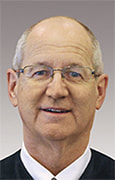Judge orders retrial or freedom for man who was visibly shacked to a wheelchair in front of jury8/6/2020  Griesbach Griesbach By Gretchen Schuldt Allowing jurors to see a defendant visibly shackled into a wheelchair during the closing arguments of his trial was so potentially prejudicial that he must be released from prison or retried, a federal judge ruled this week. The state must free Danny Wilber or initiate a new trial within 90 days, U.S. District Judge William C. Griesbach said. "It's 16½ years late," said Robert Henak, Wilber's lawyer. Wilber, now 41, was convicted in 2005 of first-degree intentional homicide in connection with the 2004 shooting of David Diaz. The case included recanted eyewitness statements and physical evidence that cast serious doubt on whether Wilber was the shooter. Wilber was sentenced to life in prison, with eligibility for extended supervision after 40 years. "The burden of proving prejudice is not Wilber’s," Griesbach wrote in his decision. "Instead, the state must prove that visibly shackling Wilber during closing argument did not contribute to his conviction....Given the inconsistent testimony of the eyewitnesses and the physical evidence suggesting Wilber could not have fired the fatal shot, the error may well have contributed to Wilber’s conviction." Henak said the physical evidence showed Wilber "could not have been the one who shot the victim." Diaz was shot in the head during a party at his South Side Milwaukee home. Two people allegedly identified Wilber as the shooter. At trial, however, both denied actually seeing the shooting, Griesbach said. Even "more problematic" was the physical evidence, he said. The medical examiner testified that evidence indicated that Diaz was shot from behind at close range. Witnesses, though, said Wilber was in front of the victim, and one witness said there was another man with a gun at the party – behind Diaz. In addition, witnesses said the gun Wilber had was a semi-automatic, which would have ejected a shell casing when fired. No casing was found, though, and a firearms expert testified that the bullet that killed Diaz was fired from a revolver. From the start of the trial, Milwaukee County Circuit Judge Mary Kuhnmuench – now retired – expressed unhappiness with Wilber's demeanor and what she perceived as his disrespectful demeanor, according to Griesbach's decision. "Beginning the first day of trial before jury selection had even begun, the trial judge cautioned Wilber that he would not be allowed to make 'facial gestures,' 'sounds,' 'act imprudently,' or be disrespectful to the court," Griesbach wrote. Kuhnmuench objected to Wilber turning to look at the prosecutor, Griesbach said. "You can’t do that," she said, according to the decision. "You have to face frontwards at all times. You’re not allowed to look back into the gallery. You’re not allowed to turn back and make faces or gestures at the state table. You’re supposed to be sitting straight in front in your chair, eyes forward, confer with your lawyer, but always facing this direction." Wilber's behavior would not be allowed to continue, she said. "One, because it’s disrespectful, and I'm going to have to take some steps to stop you if you don't do it, if you don’t stop, and I don’t want to have to do that," she said. "And the second thing is it’s -- it’s bad for you and it looks bad in front of a jury." Wilber's lawyer, Michael Chernin, explained that his client meant no disrespect, but that Wilber disagreed with the court's rulings. "What I'm trying to tell you is it's a disrespect to the court to show you disagree," Kuhnmuench said. Wilber was shackled every day of the trial, but only in hidden leg irons at first. Jury selection and discussions of legal issues dragged on for two days. Opening statements and the trial itself began on the third day. Just before lunch, Wilber again disagreed with a ruling. “You are granting everything the D.A. is throwing at you,” he told Kuhnmuench, who ordered him removed from the courtroom. "What haven't you denied, that's nothing new," Wilber said. "Put that on the record. I'm speaking up on my behalf. This is my life...You don't intimidate me with that shit, man." "You gonna hold me in contempt?" he asked when Kuhnmuench began to speak. "What, you gonna hold me in contempt. It's my life right here." The judge tried to speak again and Wilber said, "Do it." "Settle down and behave," Kuhnmuench said. "It ain’t doing me no good her overruling -- sustaining everything he throw out whether it is bogus or not," Wilber said. "Mr. Wilber, you are doing yourself no good," Kuhnmuench responded. After lunch, Wilber assured the judge that he was "all right" and understood that he had to stay in control in front of the jury. Kuhnmuench said she had increased security by bringing in two additional deputies and adding a stun belt to Wilber's attire. The deputies could use the belt, which was hidden from the jury, to shock Wilber if he misbehaved. On the fourth day, Kuhnmuench ordered the jury sequestered during their breaks and when coming and going from the courtroom. "The judge noted that the deputies had advised her that Wilber made certain statements to them, such as '[I am] not going down for this, you might as well use your gun and kill me,'" Griesbach wrote. "Wilber also asked detailed questions about the paths he would walk to the courtroom each morning, what floors they would be on, and who would have access to that same path. These questions alarmed the deputies and suggested that Wilber might attempt to flee, potentially with the help of others." On the fifth day, the prosecution asked that Wilber be directed to participate in a re-enactment of how the prosecution envisioned the shooting occurred. Chernin, Wilber's lawyer, "strenuously objected." Wilber said raising his arm the way the prosecutor wanted him to would expose the stun belt, which earned him another warning from Kuhnmuench. "Mr. Chernin, please advise him about his conduct in this court, because as I said the other day, I’m not going to have you folks mistake my kindness for weakness," she said. "I have been doing this as restrained as I can outside the presence of the jury, and given his outburst the other day, he’s lucky he hasn’t been charged with threatening a judge, that he hasn’t been charged with disorderly conduct, that he hasn’t been charged with contempt. And you know whereof I speak." By the time the jury was brought in for closing arguments, Wilber was in a wheelchair, bound at his ankles and wrists. Griesbach described the restraints: "His feet remained in shackles anchored to the floor, but now his hands were chained together at the wrists and two-inch wide black straps held both his wrists and at least one of his arms fast to the wheelchair." Kuhnmuench, Griesbach said, "stated that 'Wilber is responsible for his own predicament and for his own position, that is to be restrained and to have that obvious restraint being shown to the jury.' His behavior throughout the trial, the court stated, 'has been contemptible.'" Kuhnmuench also said that the Wilber "used absolutely inappropriate, vulgar, profane language to the deputies who were in charge of security of this courtroom" and fought with them. "That conduct will not be rewarded, it will not be tolerated, and I will not be manipulated into allowing a defendant, by his actions, to dictate how I run this court," she said. The State Court of Appeals ruled that Kuhnmuench did not err in ordering Wilber to appear bound in a wheelchair and visibly restrained, but Griesbach disagreed. "What I'm trying to tell you is it's a disrespect to the court to show you disagree." – Milwaukee County Circuit Judge Mary Kuhnmuench "Over the entire trial, the record reflects only two instances, one verbal and the other nonverbal, and both outside the jury’s presence and early in the trial, when Wilber acted inappropriately," he wrote. "This is not the kind of record that justifies visibly shackling a defendant before the jury."
The U.S. Supreme Court has recognized that shackling and gagging defendants "was so offensive and prejudicial that it could be done only as a last resort," he wrote. "Here, of course, the trial court did not order Wilber gagged, but the use of shackles, visible to the jury, conveyed the unmistakable message to the jury that Wilber was too dangerous to be permitted even the use of his hands," he said. Wilber, though did not display "the kind of extreme, persistent, and ongoing obstruction and abuse" that would justify such restraints. "Also missing in this case is any reasonable explanation as to why the visible restraints on Wilber’s hands and arms were suddenly needed just as the trial was coming to a close," Griesbach said. Some of Kuhnmuench's comments, he said, indicate she was punishing Wilber for his perceived lack of respect. "On the fifth day of the trial, for example, when she again cautioned Wilber about his reaction to her rulings, the trial judge warned him, 'You do it again, we are going to add additional restraints to you in front of the jury,'” Griesbach said. "At the time the court ordered the additional restraint, there was no indication that once seated at counsel table with his feet shackled and anchored to the floor, the stun belt around his arm, and virtually surrounded by deputies, Wilber posed any threat to the safety of the judge, her staff or the public," he said. "And based on his behavior up to that point and his continued hope for an acquittal, there was no reason to believe he would do anything to cause the jury to fear or disdain him." Kuhnmuench also was too deferential to the deputies in the courtroom in accepting their security recommendations without adequately weighing them against Wilber's fair trial rights., he said. Kuhnmuench even rejected an offer from the prosecutor to find a coat that would allow Wilber to cover the restraints. "Even if the record supported additional restraints on Wilber’s wrists and arms, however, no explanation was offered as to why the restraints had to be visible to the jury," he wrote. "After all, the chief danger that the rule against shackling the accused is intended to guard against is the risk of prejudice that displaying a defendant in shackles to the jury creates."
1 Comment
Lacey Kinnart
8/7/2020 11:10:17 pm
I am Danny Wilbers girlfriend and have been fighting this long hard fight in trying to get his freedom. Even as egregious as this shackling issue is, it is the nothing compared to what was done throughout the whole case. However; we are overjoyed that the conviction was over turned no matter what issue it was overturned by.
Reply
Your comment will be posted after it is approved.
Leave a Reply. |
Donate
Help WJI advocate for justice in Wisconsin
|
Copyright © 2024 Wisconsin Justice Initiative Inc.
The Wisconsin Justice Initiative Inc. does not endorse candidates for political office. The Wisconsin Justice Initiative Inc. is a 501(c)3 organization.
The Wisconsin Justice Initiative Inc. does not endorse candidates for political office. The Wisconsin Justice Initiative Inc. is a 501(c)3 organization.


 RSS Feed
RSS Feed